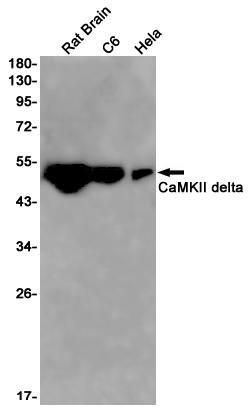Swiss-Prot Acc.Q13557.Calcium/calmodulin-dependent protein kinase involved in the regulation of Ca2+ homeostatis and excitation-contraction coupling (ECC) in heart by targeting ion channels, transporters and accessory proteins involved in Ca2+ influx into the myocyte, Ca2+ release from the sarcoplasmic reticulum (SR), SR Ca2+ uptake and Na+ and K+ channel transport. Targets also transcription factors and signaling molecules to regulate heart function. In its activated form, is involved in the pathogenesis of dilated cardiomyopathy and heart failure. Contributes to cardiac decompensation and heart failure by regulating SR Ca2+ release via direct phosphorylation of RYR2 Ca2+ channel on 'Ser-2808'. In the nucleus, phosphorylates the MEF2 repressor HDAC4, promoting its nuclear export and binding to 14-3-3 protein, and expression of MEF2 and genes involved in the hypertrophic program. Is essential for left ventricular remodeling responses to myocardial infarction. In pathological myocardial remodeling acts downstream of the beta adrenergic receptor signaling cascade to regulate key proteins involved in ECC. Regulates Ca2+ influx to myocytes by binding and phosphorylating the L-type Ca2+ channel subunit beta-2 CACNB2. In addition to Ca2+ channels, can target and regulate the cardiac sarcolemmal Na+ channel Nav1.5/SCN5A and the K+ channel Kv4.3/KCND3, which contribute to arrhythmogenesis in heart failure. Phosphorylates phospholamban (PLN/PLB), an endogenous inhibitor of SERCA2A/ATP2A2, contributing to the enhancement of SR Ca2+ uptake that may be important in frequency-dependent acceleration of relaxation (FDAR) and maintenance of contractile function during acidosis. May participate in the modulation of skeletal muscle function in response to exercise, by regulating SR Ca2+ transport through phosphorylation of PLN/PLB and triadin, a ryanodine receptor-coupling factor.

